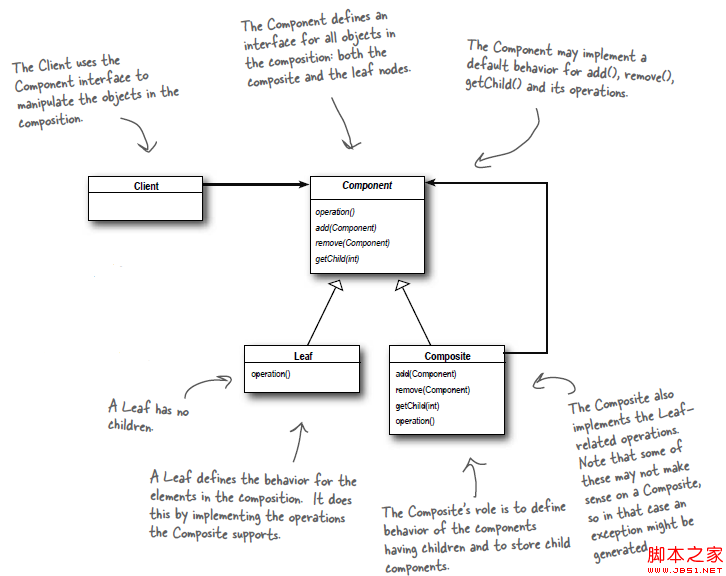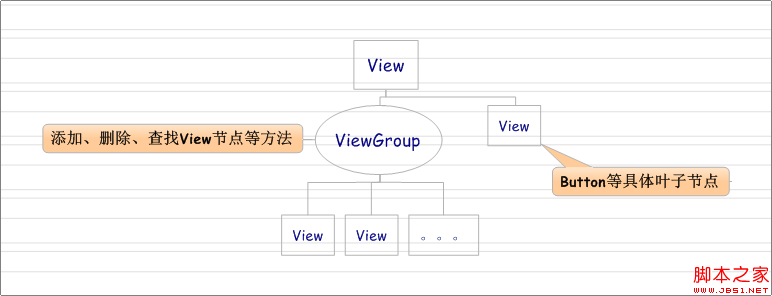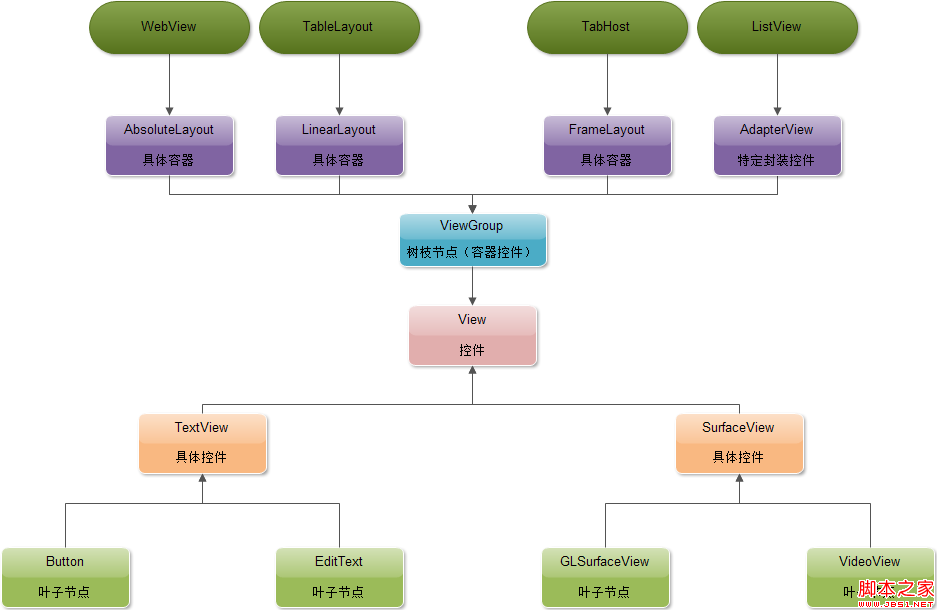組合模式定義:
Compose objects into tree structures to represent part-whole hierarchies. Composite lets clients treat individual objects and compositions of objects uniformly.
將對象組合成樹形結構以表示“部分-整體”的層次結構,使得用戶對單個對象和組合對象的使用具有一致性。

如上圖所示(截取自《Head First Design Patterns》一書),主要包括三個部分:
1. Component抽象組件。定義參加組合對象的共有方法和屬性,可以定義一些默認的函數或屬性。
2. Leaf葉子節點。構成組合樹的最小構建單元。
3. Composite樹枝節點組件。它的作用是組合樹枝節點和葉子節點形成一個樹形結構。
高層模塊調用簡單。一棵樹形結構的所有節點都是Component,局部和整體對調用者來說都是一樣的,沒有區別,所以高層模塊不比關心自己處理的是單個對象還是整個組合結構,簡化了高層模塊的代碼。
節點自由擴展增加。使用組合模式,如果想增加一個樹枝節點或者葉子節點都是很簡單的,只要找到它的父節點就可以了,非常容易擴展,符合“開閉原則”。
應用最廣的模式之一。應用在維護和展示部分-整體關系的場景,如樹形菜單、文件夾管理等等。
在Android源碼中,都能找到使用組合模式的例子,其中在《Android源碼學習之觀察者模式應用》介紹到的ViewGroup和View的結構就是一個組合模式,結構圖如下所示:

現在來看看它們是如何利用組合模式組織在一起的,首先在View類定義了有關具體操作,然後在ViewGroup類中繼承View類,並添加相關的增加、刪除和查找孩子View節點,代碼如下:
代碼如下:
* @attr ref android.R.styleable#ViewGroup_clipChildren
* @attr ref android.R.styleable#ViewGroup_clipToPadding
* @attr ref android.R.styleable#ViewGroup_layoutAnimation
* @attr ref android.R.styleable#ViewGroup_animationCache
* @attr ref android.R.styleable#ViewGroup_persistentDrawingCache
* @attr ref android.R.styleable#ViewGroup_alwaysDrawnWithCache
* @attr ref android.R.styleable#ViewGroup_addStatesFromChildren
* @attr ref android.R.styleable#ViewGroup_descendantFocusability
* @attr ref android.R.styleable#ViewGroup_animateLayoutChanges
*/
public abstract class ViewGroup extends View implements ViewParent, ViewManager {
接著看增加孩子節點函數:
代碼如下:
/**
* Adds a child view. If no layout parameters are already set on the child, the
* default parameters for this ViewGroup are set on the child.
*
* @param child the child view to add
*
* @see #generateDefaultLayoutParams()
*/
public void addView(View child) {
addView(child, -1);
}
/**
* Adds a child view. If no layout parameters are already set on the child, the
* default parameters for this ViewGroup are set on the child.
*
* @param child the child view to add
* @param index the position at which to add the child
*
* @see #generateDefaultLayoutParams()
*/
public void addView(View child, int index) {
LayoutParams params = child.getLayoutParams();
if (params == null) {
params = generateDefaultLayoutParams();
if (params == null) {
throw new IllegalArgumentException("generateDefaultLayoutParams() cannot return null");
}
}
addView(child, index, params);
}
/**
* Adds a child view with this ViewGroup's default layout parameters and the
* specified width and height.
*
* @param child the child view to add
*/
public void addView(View child, int width, int height) {
final LayoutParams params = generateDefaultLayoutParams();
params.width = width;
params.height = height;
addView(child, -1, params);
}
/**
* Adds a child view with the specified layout parameters.
*
* @param child the child view to add
* @param params the layout parameters to set on the child
*/
public void addView(View child, LayoutParams params) {
addView(child, -1, params);
}
/**
* Adds a child view with the specified layout parameters.
*
* @param child the child view to add
* @param index the position at which to add the child
* @param params the layout parameters to set on the child
*/
public void addView(View child, int index, LayoutParams params) {
if (DBG) {
System.out.println(this + " addView");
}
// addViewInner() will call child.requestLayout() when setting the new LayoutParams
// therefore, we call requestLayout() on ourselves before, so that the child's request
// will be blocked at our level
requestLayout();
invalidate(true);
addViewInner(child, index, params, false);
}
在ViewGroup中我們找到了添加addView()方法,有了增加孩子節點,肯定有相對應刪除孩子節點的方法,接著看:
代碼如下:
public void removeView(View view) {
removeViewInternal(view);
requestLayout();
invalidate(true);
}
/**
* Removes a view during layout. This is useful if in your onLayout() method,
* you need to remove more views.
*
* @param view the view to remove from the group
*/
public void removeViewInLayout(View view) {
removeViewInternal(view);
}
/**
* Removes a range of views during layout. This is useful if in your onLayout() method,
* you need to remove more views.
*
* @param start the index of the first view to remove from the group
* @param count the number of views to remove from the group
*/
public void removeViewsInLayout(int start, int count) {
removeViewsInternal(start, count);
}
/**
* Removes the view at the specified position in the group.
*
* @param index the position in the group of the view to remove
*/
public void removeViewAt(int index) {
removeViewInternal(index, getChildAt(index));
requestLayout();
invalidate(true);
}
/**
* Removes the specified range of views from the group.
*
* @param start the first position in the group of the range of views to remove
* @param count the number of views to remove
*/
public void removeViews(int start, int count) {
removeViewsInternal(start, count);
requestLayout();
invalidate(true);
}
private void removeViewInternal(View view) {
final int index = indexOfChild(view);
if (index >= 0) {
removeViewInternal(index, view);
}
}
private void removeViewInternal(int index, View view) {
if (mTransition != null) {
mTransition.removeChild(this, view);
}
boolean clearChildFocus = false;
if (view == mFocused) {
view.clearFocusForRemoval();
clearChildFocus = true;
}
if (view.getAnimation() != null ||
(mTransitioningViews != null && mTransitioningViews.contains(view))) {
addDisappearingView(view);
} else if (view.mAttachInfo != null) {
view.dispatchDetachedFromWindow();
}
onViewRemoved(view);
needGlobalAttributesUpdate(false);
removeFromArray(index);
if (clearChildFocus) {
clearChildFocus(view);
}
}
/**
* Sets the LayoutTransition object for this ViewGroup. If the LayoutTransition object is
* not null, changes in layout which occur because of children being added to or removed from
* the ViewGroup will be animated according to the animations defined in that LayoutTransition
* object. By default, the transition object is null (so layout changes are not animated).
*
* @param transition The LayoutTransition object that will animated changes in layout. A value
* of <code>null</code> means no transition will run on layout changes.
* @attr ref android.R.styleable#ViewGroup_animateLayoutChanges
*/
public void setLayoutTransition(LayoutTransition transition) {
if (mTransition != null) {
mTransition.removeTransitionListener(mLayoutTransitionListener);
}
mTransition = transition;
if (mTransition != null) {
mTransition.addTransitionListener(mLayoutTransitionListener);
}
}
/**
* Gets the LayoutTransition object for this ViewGroup. If the LayoutTransition object is
* not null, changes in layout which occur because of children being added to or removed from
* the ViewGroup will be animated according to the animations defined in that LayoutTransition
* object. By default, the transition object is null (so layout changes are not animated).
*
* @return LayoutTranstion The LayoutTransition object that will animated changes in layout.
* A value of <code>null</code> means no transition will run on layout changes.
*/
public LayoutTransition getLayoutTransition() {
return mTransition;
}
private void removeViewsInternal(int start, int count) {
final View focused = mFocused;
final boolean detach = mAttachInfo != null;
View clearChildFocus = null;
final View[] children = mChildren;
final int end = start + count;
for (int i = start; i < end; i++) {
final View view = children[i];
if (mTransition != null) {
mTransition.removeChild(this, view);
}
if (view == focused) {
view.clearFocusForRemoval();
clearChildFocus = view;
}
if (view.getAnimation() != null ||
(mTransitioningViews != null && mTransitioningViews.contains(view))) {
addDisappearingView(view);
} else if (detach) {
view.dispatchDetachedFromWindow();
}
needGlobalAttributesUpdate(false);
onViewRemoved(view);
}
removeFromArray(start, count);
if (clearChildFocus != null) {
clearChildFocus(clearChildFocus);
}
}
/**
* Call this method to remove all child views from the
* ViewGroup.
*/
public void removeAllViews() {
removeAllViewsInLayout();
requestLayout();
invalidate(true);
}
/**
* Called by a ViewGroup subclass to remove child views from itself,
* when it must first know its size on screen before it can calculate how many
* child views it will render. An example is a Gallery or a ListView, which
* may "have" 50 children, but actually only render the number of children
* that can currently fit inside the object on screen. Do not call
* this method unless you are extending ViewGroup and understand the
* view measuring and layout pipeline.
*/
public void removeAllViewsInLayout() {
final int count = mChildrenCount;
if (count <= 0) {
return;
}
final View[] children = mChildren;
mChildrenCount = 0;
final View focused = mFocused;
final boolean detach = mAttachInfo != null;
View clearChildFocus = null;
needGlobalAttributesUpdate(false);
for (int i = count - 1; i >= 0; i--) {
final View view = children[i];
if (mTransition != null) {
mTransition.removeChild(this, view);
}
if (view == focused) {
view.clearFocusForRemoval();
clearChildFocus = view;
}
if (view.getAnimation() != null ||
(mTransitioningViews != null && mTransitioningViews.contains(view))) {
addDisappearingView(view);
} else if (detach) {
view.dispatchDetachedFromWindow();
}
onViewRemoved(view);
view.mParent = null;
children[i] = null;
}
if (clearChildFocus != null) {
clearChildFocus(clearChildFocus);
}
}
/**
* Finishes the removal of a detached view. This method will dispatch the detached from
* window event and notify the hierarchy change listener.
*
* @param child the child to be definitely removed from the view hierarchy
* @param animate if true and the view has an animation, the view is placed in the
* disappearing views list, otherwise, it is detached from the window
*
* @see #attachViewToParent(View, int, android.view.ViewGroup.LayoutParams)
* @see #detachAllViewsFromParent()
* @see #detachViewFromParent(View)
* @see #detachViewFromParent(int)
*/
protected void removeDetachedView(View child, boolean animate) {
if (mTransition != null) {
mTransition.removeChild(this, child);
}
if (child == mFocused) {
child.clearFocus();
}
if ((animate && child.getAnimation() != null) ||
(mTransitioningViews != null && mTransitioningViews.contains(child))) {
addDisappearingView(child);
} else if (child.mAttachInfo != null) {
child.dispatchDetachedFromWindow();
}
onViewRemoved(child);
}
同樣的,也有查找獲得孩子節點的函數:
代碼如下:
/**
* Returns the view at the specified position in the group.
*
* @param index the position at which to get the view from
* @return the view at the specified position or null if the position
* does not exist within the group
*/
public View getChildAt(int index) {
if (index < 0 || index >= mChildrenCount) {
return null;
}
return mChildren[index];
}
注:其中具體葉子節點,如Button,它是繼承TextView的,TextView是繼承View的,代碼如下:
代碼如下:
public class TextView extends View implements ViewTreeObserver.OnPreDrawListener {
。。。
}
注:其中使用(繼承)到ViewGroup類的有我們常用的容器類(包裝和容納各種View),如LinearLayout、FrameLayout等,代碼如下:
代碼如下:
public class LinearLayout extends ViewGroup {
public static final int HORIZONTAL = 0;
public static final int VERTICAL = 1;
。。。
}
public class FrameLayout extends ViewGroup {
...
}
public class RelativeLayout extends ViewGroup {
private static final String LOG_TAG = "RelativeLayout";
private static final boolean DEBUG_GRAPH = false;
...
}
public class AbsoluteLayout extends ViewGroup {
public AbsoluteLayout(Context context) {
super(context);
}
}
...
最後送上“基本控件繼承關系圖”:

本人能力有限,寫的很粗糙,恭候大家的批評指正,謝謝~~~



 Android自定義ActionBar實例
Android自定義ActionBar實例
 android 9PNG圖片制作過程(圖文介紹)
android 9PNG圖片制作過程(圖文介紹)
 Android本地化
Android本地化
 Android人臉檢測的開發實例
Android人臉檢測的開發實例